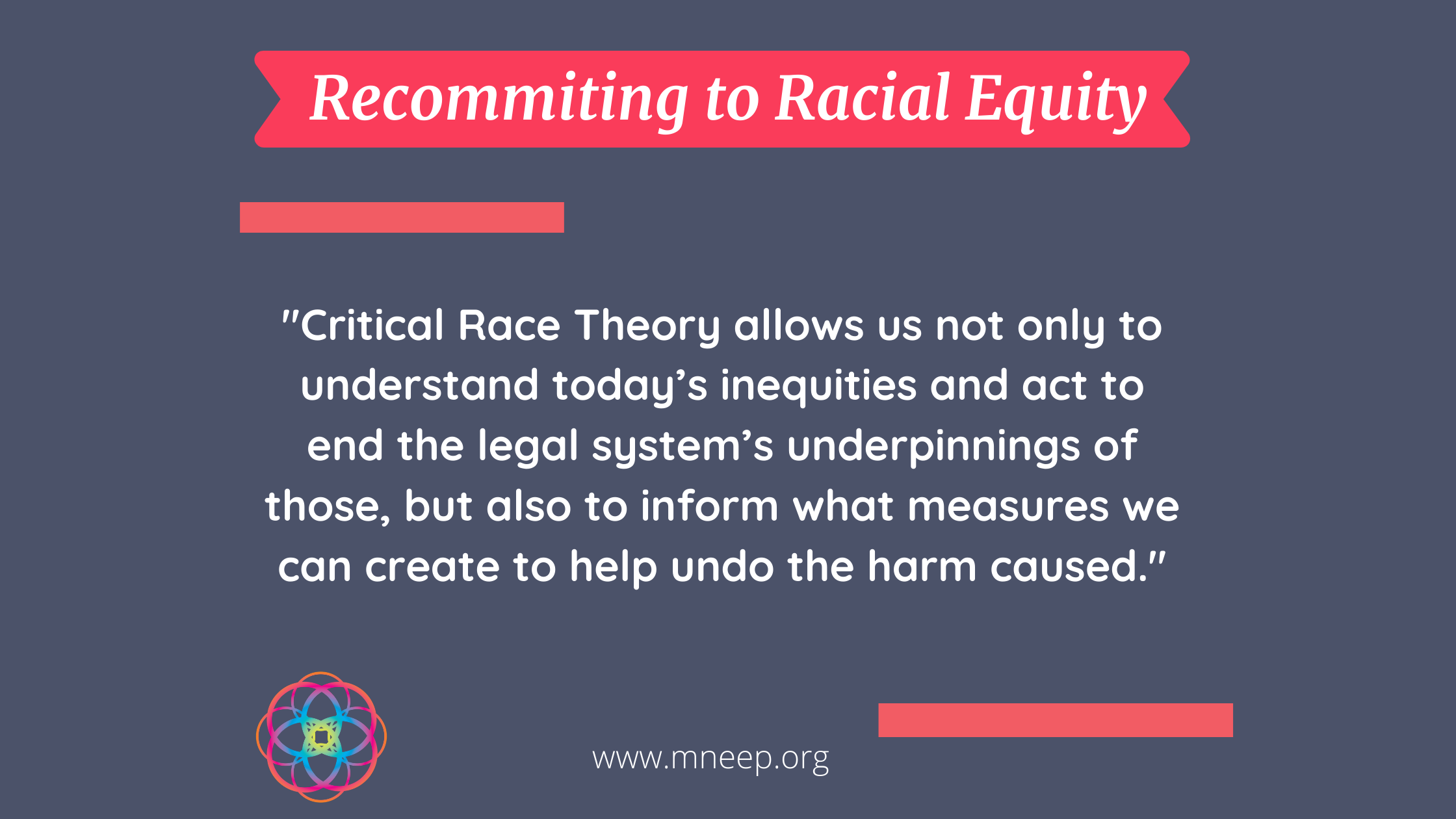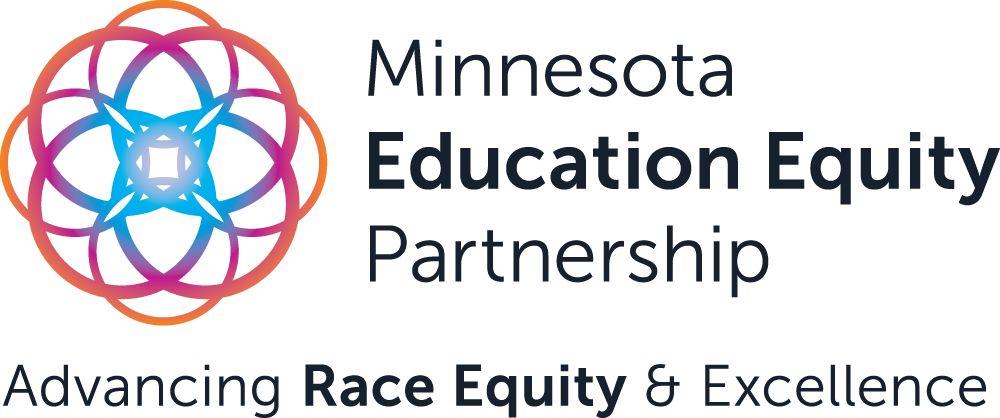
Anti-CRT and Minnesota schools: Why educators and school leaders must recommit to racial equity this school year
As the school year begins among anti-Critical Race Theory rhetoric and attacks on race equity polices, plans, and practices MnEEP calls for a recommitment to racial justice in Minnesota schools.
At MnEEP, we believe addressing and building racial equity is central to creating school systems that are beneficial for each—and every—student. This is why we partner with school districts across Minnesota to provide school leaders and educators with the tools, resources, and deep understanding they need to advance racial equity in their schools and classrooms and ensure Black, Latino/Latina, Asian, Pacific Islander, and Indigenous students (POCI students – People of Color/Indigenous) have the opportunity to realize their full potential and achieve academic excellence.
A critical component of building racial equity in education means students have the historical knowledge and safe space to talk constructively about race and racism, including learning and understanding the tenets of critical race theory (CRT)— a tool developed by POCI scholars to analyze how our legal and institutional systems have advanced structural racism.
Yet even with the powerful personal, social, and economic benefits that come from students understanding how systemic, structural, and institutional racism has worked and continues to work in our country, there are efforts being made nationwide and statewide to deny that opportunity to students.
The anti-CRT rhetoric greatly concerns us at MnEEP, and it should concern anyone who truly wishes to close the deep education opportunity gaps in Minnesota.
This is why, at this critical juncture and the beginning of another school year, we are calling on and empowering Minnesota educators, school leaders, and racial equity champions to recommit to racial equity and racial justice, to undoing the current and historical harms of racism, and to building anti-racist education spaces where every student receives the tools, resources, and supports they need to succeed.
To build a prosperous, multiracial state where everyone has the opportunity to build the life they deserve, it’s essential we work together to advance racial equity rooted in these core principles:
Racism is real.
MnEEP asserts that racism is real, and it is not constrained to the horrific harms done in the past. We live out the ongoing consequences of that harm, and they show up in the social disparities we see today that fall along racial lines.
For instance, only 65 percent of Black young men complete high school on-time in Minnesota. Their white male colleagues on other hand graduate on-time at rates 86 percent. There is nothing biologically different about these young men, but the disparate statistical reality between them as groups tells a persistent story of how racism impacts them differently.
Acknowledging that these disparities exist, understanding there are no natural laws for them to exist, and analyzing the powerful social forces that produce these outcomes allows us to better provide opportunities for achievement in our schools so our educational institutions can overcome the harm of racism.
We owe it to students to equip ourselves with information we can use to make our schools more effective for each and every student.
MnEEP is not surprised by the conjuring of misinformation over CRT. We see it as the latest development of a historical pattern of resistance to anti-racism efforts across the country. That resistance has and continues to harm our students and our communities, and serves to perpetuate white racial supremacy.
It impedes us all from acting to remake our public institutions to be places where each person has opportunities to succeed and and is not limited from doing so.
Our students deserve racial equity.
Racial equity is the social condition where every person receives what they need to be successful in recognition of how racism has denied them the very things that have created benefits for other racial groups.
To act equitably in education, the rules and practices of our schools and colleges intentionally act to know how racism has impacted their students and provides opportunities —even if some of those differ per racial student groups —so that each and all can benefit.
Racism singles out groups of people for immediate specific harm while having consequences that can last generations. African Americans were denied the benefits of the federal G.I. Bill, even though they had earned it by sacrificing their lives in military defense of our nation. Meanwhile, white families built up early economic and social advantages by having full access to it.
Ignoring this fact leads schools to fail with students of color and Indigenous students by assuming they possess the same advantages around which to align how to deliver education. Ignoring the unique ways racism has impacted different students consistently leads to the failed approach of providing education to all students using the same methods for all. The result is structuring opportunities that work well for some, but not for all. We call that the “opportunity gap”.
To overcome the unfair expectation that everyone be treated “the same” regardless of how they have been harmed and limited by racism, our institutions must take actions that are informed precisely by those harmful limitations and act to counter them.
For example, after-school programs become ways for schools to provide exposure to careers that some white students privately have access to due to accumulated family wealth that flowed from the long-ago benefits of the G.I. Bill.
Racial equity then is about doing the specific things that must be informed by the unique experiences of each racial-cultural group. Only then can opportunities truly be thought of us as “being equal,” where “equal” means to respond to the unique impediments all and each student face in their lives.
To overcome the unfair expectation that everyone be treated “the same” regardless of how they have been harmed and limited by racism, our institutions must take actions that are informed precisely by those harmful limitations and act to counter them.
CRT is an essential tool for understanding racism.
Critical race theory (CRT) is one tool that allows us to understand what those impediments are, and how they continue to harm people based on their perceived racial class—and it empowers us to act fairly. In its simplest form, CRT it is a telling of our society’s legal constructs created to perpetuate racially disparate opportunities to cause harm to POCI people and their communities.
In our classrooms and for our educators, CRT simply provides a framework for understanding how law and policy in the United States creates and perpetuates racial harm.
For instance, the permanence of racism can be seen in how, for generations, Minneapolis had legally enforceable, racially exclusive covenants on property title transfers that forbade home ownership by African Americans in certain neighborhoods.
This enabled racial segregation through property law. It took proactive state legislation in 1953 to ban new covenants in Minnesota, though their legacy still persists. To this day, the Twin Cities still have the lowest African American homeownership rates in the country.
Banning racial covenants was one act of racial equity—acting specifically to undo a law targeting African Americans to limit their opportunities for homeownership. This is what CRT allows us to do—to see and understand how systemic behavior causes racial harm, in this case how it was perpetuated through our legal system and still impacts Black Minnesotans today.
Tools and frameworks like CRT allow us not only to understand today’s inequities and act to end the legal system’s underpinnings of those, but also to inform what measures we can create to help undo the harm caused.
For example, because racially segregated neighborhoods allowed for wealth to be amassed by white families that could then be used for college tuition while African Americans were denied access to that accumulation of wealth, college scholarships for students of color and Indian students becomes a justifiable— “equitable”— act towards equal opportunities.
With this in mind, the present challenge to CRT raises the question: Why would we not want to see and understand what, where, when, and how racial harm is done in our society? And given that a school’s purpose is to prepare young people to be productive citizens in society, why would we not want students to develop the skills to understand racism?
And if a key purpose of our education systems is to equip our people to be effective citizens, we should equip them with the tools and knowledge to see racism, understand how it is perpetuated, engage them in moving past the falseness of color blindness, and empower each citizen to play their part in solving how to end racism.
Thus, when CRT rightly exposes racial supremacy, it is characterized as an attack on America. However, this could only be true if America chooses to be a white supremacist state.
Racial equity empowers students and our society.
The benefits of racial equity as an educational outcome are many:
- Race equity fosters appreciation for diversity, which leads to peaceful co-existence in a multicultural society;
- It nurtures skills for communicating and working effectively across diverse backgrounds, which enhances our effectiveness and prosperity;
- It fosters respect for the inherent dignity of all people which affirms our civil rights and strengthens democracy and the rule of law in our Constitutional republic.
These are critically important outcomes for our multiracial democracy.
Racial equity empowers school leaders, educators, and our communities.
Teachers, school boards, and superintendents are acquiring a deeper knowledge of what that critical engagement with students requires of them in order to become better educators and guide their students’ academic achievement.
They call on MnEEP and others for guidance on how to better address racial equity, not because they desire to advance an ideology, but because they know directly from their students that aligning the educational environment and delivery system to racial equity is necessary for each student to develop the self-agency needed to succeed.
We must meet this moment.
And yet, despite these developments, critics of CRT have been quite open in arguing that equity is wrong. They have mischaracterized and couched racial equity as furthering the diminishment of “American norms” and of the self-worth of white students.
To appreciate the power being conjured by misinformation in this moment through the attacks on public schools for “teaching CRT” requires a deeper understanding of how racism has been constructed in our society so that ideas of white supremacy are equated with being American.
Thus, when CRT rightly exposes racial supremacy, it is characterized as an attack on America. However, this could only be true if America chooses to be a white supremacist state.
But there is a version, and a historical practice, of America being something else, and tools like CRT make it possible for that aspiring version, which authentically values “we the people” to succeed.
But as we collectively struggle – to name and end racial supremacy and disentangle ourselves from its lies that we have normalized (perhaps often not being aware they were untrue and causing harm) – we need to work through the feelings that conjures up for us.
For instance, when CRT makes it possible to see things like the racist Minneapolis property covenants, some Minnesotans can be offended by the suggestion that we must be a “bad people.” That devaluing of self and the sense of loss it brings can be both infuriating and frightening and can—in an electoral political environment – be manipulated to meet a partisan and ideological purpose at odds with racial justice.
MnEEP understands this and, while not interested in passing judgement on those who have been manipulated to use CRT to attack diversity engagement and racial equity, we remain fiercely steadfast in challenging the argument that racial equity should not be pursued in our education systems, and we strongly contest the demand that students should not learn about racism.
This is an opportunity.
MnEEP believes the recent attacks open an opportunity to understand CRT as the helpful tool it is to better understand how we have structured our society to cause racial harm, including denying true opportunities for many students.
We see this moment as a time to recommit ourselves to being an empowered people that can move past that harm —equipped with good tools—to build the society each of us deserves, where everyone has real access and opportunities, where we can work to end racism.
Please visit the MnEEP website www.mneep.org and engage in a community committed to doing just that.
- MnEEP Race Equity Glossary: Concepts, Definitions, Processes, and Tools for Advancing Race Equity
- New York Times: What is Critical Race Theory?
- National Education Association (NEA): NEA’s Racial Justice in Education Framework
- Thriving Schools: The Importance of Racial Equity for Thriving Schools

